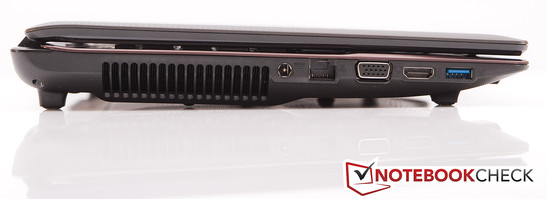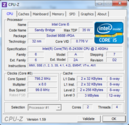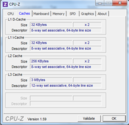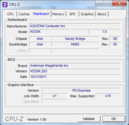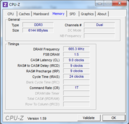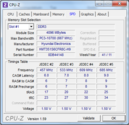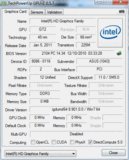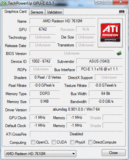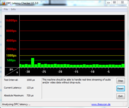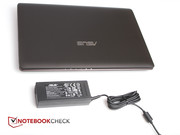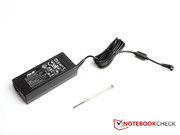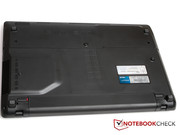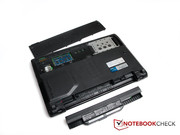Review Asus X53SK-SX028V Notebook
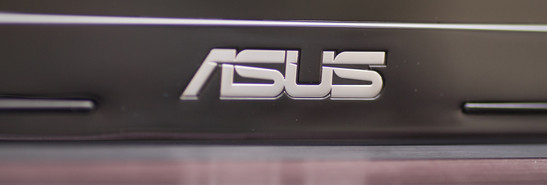
Asus pitches the X53SK as a multimedia notebook based on the Intel Core i5-2430M. In doing so it drafts in a tried and tested case. We already became familiar with the case when we reviewed the Asus X53E, from the TestIT!2011 campaign and from the K-series notebooks.
Our model is the SX028V variant. This is supplied with an Intel Core i5-2430M processor, 6 GB of RAM, an AMD Radeon HD 7610M graphics card and a 500 GB hard disk. There's one more variant of the Asus X53SK, namely the SX069V version. This, however, is equipped with an Intel Core i7-2670QM, 6 GB of RAM, an AMD Radeon HD 7610M graphics card and a 750 GB hard disk.
As we are already familiar with the case, keyboard and touchpad from other reviews, we're not going to dwell on them in this review. Because of this, you can look them up in the test reports of the Asus X53E-SX082V or the Asus K53SV-SX131V, for example.
When it comes to the model numbers there could be ambiguities, as the models from the K53 range and the X53 range match each other, with the exception of minimal differences in specification. As a result, some large online retailers have simply listed the notebook as the K53/X53. Incidentally we would meanwhile like to refer to the coming review of an almost identical notebook from the K53 range, which will show more of an interest in the gaming domain due to a focus on the graphics performance of the HD 7610M GPU.
Connectivity
As we already know about the case, the connections are all arranged rather far forwards. This has the disadvantage that the front area can quickly become crowded. For example, both USB 2.0 connections are on the right side. For another thing, when extensively using the range of ports on the notebook on a desk, for example, it quite quickly leads to an unsightly jumble of cables. There are no surprises when it comes to the range of interfaces. Asus includes pretty much everything necessary for daily use, yet isn't excessively generous. All the same, there's a fast USB 3.0 interface.
Communication
Here too, Asus offers almost everything you need for general use. There's LAN in both tethered and wireless variants. Whilst Realtek provides the wired solution, WLAN connectivity is supplied by Atheros. The Atheros adaptor supports the wireless standards 802.11 B/G/N, whilst the Realtek adaptor supports speeds of 10 MBit/s, 100 MBit/s, and 1000 Mbit/s. The only disappointment is the lack of Bluetooth. If you want to connect an external wireless mouse or anything similar, you'll have to sacrifice one of the three USB connections for a corresponding adaptor.
Accessories
The delivery contents turn out to be rather limited, as usual. Alongside the notebook, the battery and the power supply together with the set of cables, there's only some printed documentation in the box. As has become the norm for consumer notebooks, there's no manufacturer DVD included.
Maintenance
On the underside of the notebook there's a maintenance hatch, which is opened after removing two screws. Under the hatch RAM, hard disk and WLAN module are accessible. In our test sample both RAM slots are already occupied. The hard disk is secured by another pair of screws, yet it can easily be replaced. The user is not given access to the fans or the CPU.
Warranty
Asus offers the X53SK with a 2-year warranty covering hardware defects and a 1-year warranty that covers the battery.
Display
Asus dons the X53SK with a 15.6-inch 16:9 display with a 1366 x 768 resolution. The panel has the now standard LED background as well as a reflective display.
Asus has opted to equip the X53SK with a 08/15 consumer display with glossy surface, which is clear, at the latest, when observing our data. With an average brightness of 212.3 cd/m², the display isn't excessively bright. Some competitors reach better values within the same price bracket. At least Asus doesn't lower the brightness of the display automatically when using the notebook on battery power. The illumination, at 83 percent, can be considered good, but here too it's clear that there's better.
The biggest weakness of the cheap panel is, however, the contrast. On the X53SK it's a lowly 175:1. The lukewarm image contrast of the notebook is the result of the brightness values and the black level. At 1.25 cd/m², the black level is much too high. This results in grey surfaces in games and films, which should otherwise be black.
| |||||||||||||||||||||||||
Brightness Distribution: 83 %
Center on Battery: 219 cd/m²
Contrast: 175:1 (Black: 1.25 cd/m²)
When it comes to using the notebook outdoors, the display performs as well as you would expect from a reflective panel. What might still be visible in the shadows no longer makes for reasonable work in the sun.
In sunlight the display reflects so strongly that you can see what's going on behind you much better than the actual screen content.
There are no surprises when it comes to viewing angle stability, which is average or slightly above average, at best. If you look directly at the display you and several others can take a seat in front of the notebook problem-free. As soon as the display is slanted upwards or downwards the image deteriorates.
Performance
The Asus X53SK is a multimedia notebook and should thus cover a broad spectrum of fields of application. It's equipped with a mid-range processor and a mid-range graphics card, which present a compromise between performance and energy consumption. Therefore, this notebook is suitable for some games, as well as being a mobile companion with reasonable battery life.
Processor
The Asus X53SK is served by an Intel Core i5-2430M, a mid-range Sandy Bridge processor. The dual-core processor has a basic clock speed of 2.4 GHz and can be overclocked on demand up to 3.0 GHz. Intel Turbo Boost takes care of this so that the user doesn't even notice the overclocking taking place. In addition, the processor has Intel's Hyper-Threading technology, meaning the processor can simultaneously execute four threads, instead of two. The performance of the 2430M processor is higher than that of comparable processors from the previous range, thanks to optimised Sandy Bridge architecture. Therefore, the 2430M can be said to be on the same level as the Core i5-560M that runs at 2.7-3.2 GHz. The TDP of the processor is 35 Watt. In the TDP value, not only was the 2430M processor considered, but also its memory controller and integrated graphics. At 35 Watt, the processor is suitable for 14-inch notebooks and upwards. For more information about the Intel Core i5-2430M visit our CPU info page.
We used the 64-bit version of CineBench R10 to check the performance of the Intel Core i5-2430M processor. In the Cinebench R10 Rend. Single (64bit) benchmark, which just utilises one processor core, the notebook reaches 4752.0 points. Compared with other notebooks with the i5-2430M processor, it comes out mid-table. For example, the Samsung 700Z5A-S01DE (2430M, HD 6750M) reached 4809.0 points, whilst the MSI GE620-i748W7P (2630QM, GT 540M) scored 4660.0 points.
On the second benchmark test, the Cinebench R10 Rend. Multi (64bit) benchmark, the performance of all processor cores comes into play. Here the Asus X53SK reached 9885.0 points. Here too, the 2430M processor of the X53SK notebook ends up mid-table in the league of 2430M processors. A comparable result is once again provided by the Samsung 700Z5A-S01DE (2430M, HD 6750M), with 9991.0. Below the Asus notebook there are notebooks with the somewhat weaker 2410M processor, like the Asus K53SV-SX131V (2410M, GT 540M), which scored 9620.0 points.
Checking the performance of the Turbo Boost function on the Asus X53SK ran as we had hoped: impeccably. If one core is under load, the core speed increased to 3.0 GHz. If several processor cores are under load, the value is lower. If the performance potential of the processor isn't necessary, it automatically switches to energy-saving mode (800 MHz).
System Performance
In order to assess system performance, we use both PC Mark Vantage and PC Mark 07.
In the PC Mark Vantage benchmark the Asus X53SK scores 5965.0 points. Therefore in our benchmark table the notebook is just above the Toshiba Satellite L750-16W (2430M, GT 525M) with 5922.0 points. Somewhat above the Asus X53SK is the K53SV (2410M, GT 540M), another Asus notebook, with 6043.0 points.
On PC Mark 07 the X53SK makes up ground and is above both of the notebooks from the PC Mark Vantage test with 1878.0 points. The Toshiba Satellite L750-16W (2430M, GT 525M) notebook reaches 1695.0 points here, whilst the Asus K53SV (2410M, GT 540M) scores 1876.0 points.
| PCMark Vantage Result | 5965 points | |
| PCMark 7 Score | 1878 points | |
Help | ||
Mass storage
In the test sample there was a 2.5" Western Digital WD5000BPVT-80HXZT3 drive. The platters spin at 5400 rpm and have a (gross) capacity of 500 GB. The values we attained for the hard disk are rather average. An average transfer rate of 71.5 MB/s as well as an access time of 19.9 milliseconds aren't anything special nowadays.
Graphics solution
The Asus X53SK has two graphics solutions. The first is an economical graphics card integrated into the processor, the Intel HD Graphics 3000, whilst the second is the more powerful AMD Radeon HD 7610M graphics card. There's not much to say about the integrated graphics card. It's obviously the slower of the two, yet is much more economical. Above all it's suitable for simple tasks in day-to-day computing, like surfing the web or office work.
As for the AMD Radeon HD 7610M, it's a DirectX11-capable mid-range graphics card. It's suitable for more demanding tasks like photo- or video-editing. It can also cope with some more recent games. Admittedly, the user pays for better performance in the form of much lower battery life. The user can, of course, switch between both graphics cards whilst the notebook is running, and this can be done both manually and automatically. After right-clicking on the desktop you can select the options "graphics properties" or "configure switchable graphics" to customize switching between the graphics cards according to your requirements.
3D Mark 06 is used to judge the performance of the graphics cards. Here, the Asus notebook reaches a score of 7100.0 points. Therefore, according to our assessment, it's placed slightly above notebooks like the Fujitsu Lifebook AH531 (2310M, GT 525M) with 7028.0 points. The Asus X53SK admittedly does have to admit defeat when faced with notebooks like the HP Pavilion dv6-6110eg (A6-3410MX, HD6755G2) with 7380.0 points.
| 3DMark 03 Standard | 19207 points | |
| 3DMark 05 Standard | 12530 points | |
| 3DMark 06 Standard Score | 7100 points | |
| 3DMark Vantage P Result | 3741 points | |
| 3DMark 11 Performance | 849 points | |
Help | ||
Gaming Performance
Of course the Asus X53SK had to undergo some game tests. Therefore we used Deus Ex Human Revolution and The Elder Scrolls V: Skyrim. At low settings both games ran smoothly, but as soon as we increased the settings, the games reached their limits in terms of playability. At high settings Skyrim only ran at 17 fps and was thus no longer playable.
Other games can be peeked at in our extensive game comparison. Additionally, we are soon publishing a review of the Asus K53SK notebook, in which the review's emphasis will be on the gaming performance of the aforementioned GPU.
| low | med. | high | ultra | |
|---|---|---|---|---|
| Deus Ex Human Revolution (2011) | 35 | 30 | ||
| The Elder Scrolls V: Skyrim (2011) | 40 | 27 | 17 |
Emissions
System Noise
Thankfully the notebook's fan isn't constantly active. When idle there are phases in which the fan is completely turned off. This leaves only the noise of the hard disk noticeable. The volume of the notebook when idle is between 30.7 dB(A) and 32.6 dB(A). This means that the notebook is nicely quiet and inconspicuous. Under load the notebook becomes oddly louder: 32.5 dB(A) – 39.8 dB(A). The DVD drive creates a considerable noise level of 34.6 dB(A) in use. During quieter film scenes this can be annoying, but in normal use this isn't really obvious.
Noise level
| Idle |
| 30.7 / 30.7 / 32.6 dB(A) |
| HDD |
| 31.2 dB(A) |
| DVD |
| 34.6 / dB(A) |
| Load |
| 32.5 / 39.8 dB(A) |
 | ||
30 dB silent 40 dB(A) audible 50 dB(A) loud |
||
min: | ||
Temperature
The notebook's surfaces remain at a pleasant temperature at all times. When idle, the maximum temperature on the upper side is no more than 28.5 degrees Celsius, whilst the maximum temperature on the underside is 31.6 degrees Celsius. The temperature on the palm rests is also very low. Under load the maximum temperatures on the upper side climb to 35.8 degrees Celsius and up to 37.2 degrees Celsius on the underside. This means that the maximum temperature is around body temperature. The palm rests are also pleasant under load. Asus ensures palm rests are kept at the right temperature with IceCool technology.
In our full-load test with FurMark and Prime the processor temperature recorded via "Hardware Monitor" climbed to 77 degrees Celsius. Thus, the maximum temperature is still much below dangerous values. No throttling or other performance losses could be determined during the test. Also the subsequent 3D Mark 06 benchmark only slightly differed, at 7038.0 points, from the result achieved when "cold" (7100.0 points).
(+) The maximum temperature on the upper side is 35.8 °C / 96 F, compared to the average of 36.9 °C / 98 F, ranging from 21.1 to 71 °C for the class Multimedia.
(+) The bottom heats up to a maximum of 37.2 °C / 99 F, compared to the average of 39.2 °C / 103 F
(+) In idle usage, the average temperature for the upper side is 25.1 °C / 77 F, compared to the device average of 31.3 °C / 88 F.
(+) The palmrests and touchpad are cooler than skin temperature with a maximum of 28.5 °C / 83.3 F and are therefore cool to the touch.
(±) The average temperature of the palmrest area of similar devices was 28.7 °C / 83.7 F (+0.2 °C / 0.4 F).
Speakers
Subjectively, the Altec Lansing speakers provide a really balanced sound. Indeed the high notes could be more pronounced, but for notebook speakers they are thoroughly all right. You can't really expect clear basses as there's no subwoofer, leaving associated low notes absent from the package.
Battery Life
Energy consumption
The consumption values of the Asus X53SK were measured in the test with the AMD graphics card, and as a result the values turned out somewhat higher than they would have, if the integrated Intel graphics had been active. In the test report of the Asus K53SK-SX021V there are the relevant measurement results on the internal Intel graphics card. In idle mode the consumption values with Intel graphics are much lower. With AMD graphics with no load the notebook indulges itself in a whole 13.7 Watt – 15.6 Watt.
Under load the consumption values are all right at 35.6 Watt – 69.2 Watt. The 90 Watt power supply provided has no problem powering the notebook at any time.
| Off / Standby | |
| Idle | |
| Load |
|
Key:
min: | |
Battery Life
The battery life was measured by Battery Eater. In the Reader's Test the maximum battery life is obtained. For this reason the display brightness is set to the lowest possible setting and networking is deactivated. This leaves the notebook reaching a battery life of 4 hours and 19 minutes. Admittedly you will rarely reach this in reality. More likely, real-world battery life will be more like the results of the WLAN-Surf test. Display brightness is set to medium and networking is on, and the notebook browses the web until the battery runs out. Here the notebook reached 3 hours and 31 minutes, which is what the average user is likely to encounter problem-free. In the Classic test a load scenario is simulated. Here the X53SK runs on the battery for 1 hour and 18 minutes. In order to completely charge the battery, the notebook has to be plugged in for 1 hour and 49 minutes.
Verdict
We were already familiar with the case, the keyboard and the touchpad from other Asus notebooks and so here we've had no surprises. The case gives a significant and solid impression and the input devices allow you to pleasantly work on the notebook.
However, when compared to other notebooks that share the case, this notebook doesn't perform so well when it comes to the connections on offer. The range of connections is considered to be below limits, yet there is a USB 3.0 connection.
The battery life of the notebook is okay. Indeed you won't be able to make the whole day without charging, but you really can use the notebook without being too close to a plug.
As is so often the case for notebooks in this price range, the display is disappointing. Whilst the brightness might be okay, the weak contrast and the black level being too high let down the display. Also working outdoors isn't really possible due to the reflective panel.
However, the good application performance, the low case temperatures and the low in-use system noise turned out positively.
The X53SK from Asus proves to be a low-priced multimedia notebook that is suitable for many scenarios. The processor and graphics card make a sensible duo and bring about a sound measure of performance with acceptable battery life.




